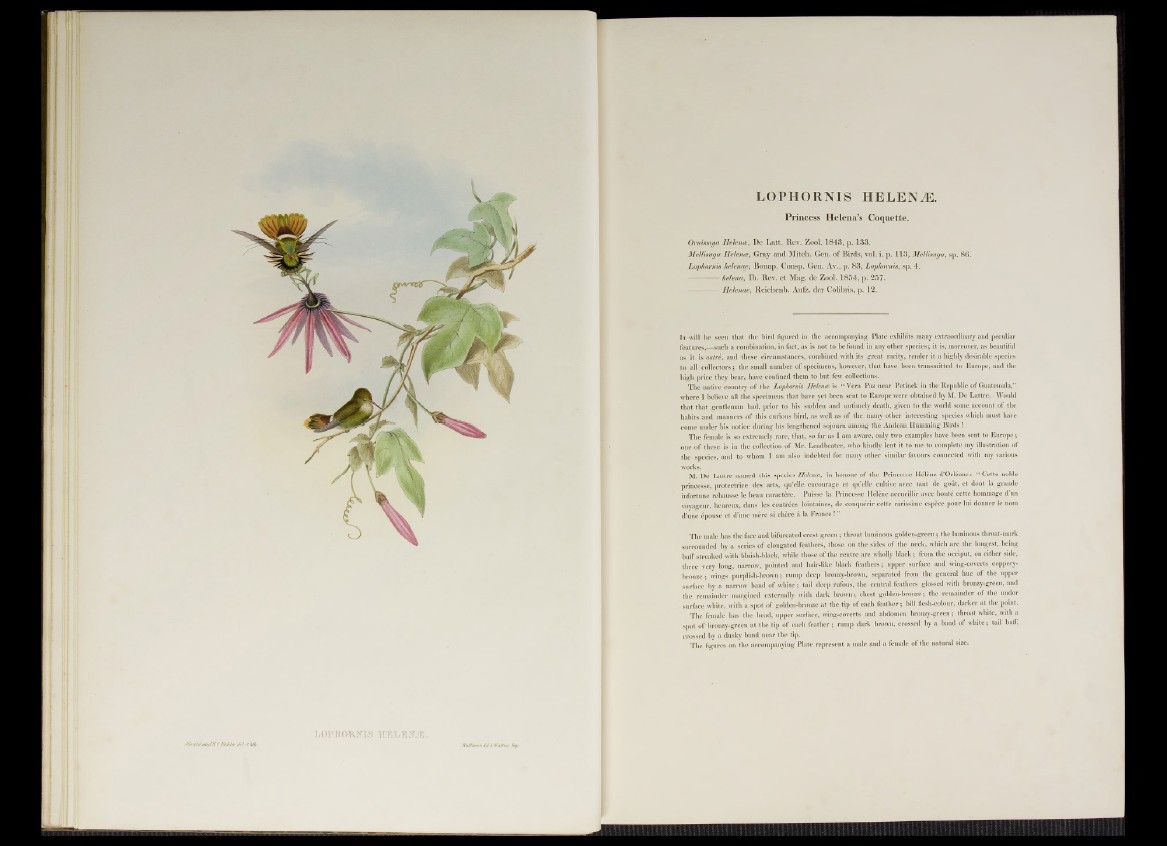
LOPHORNIS HELENÆ.
Princess Helena’s Coquette.
Ornismya Helena, De Latt. Rev. Zool. 1843, p. 133.
Mellisuga Helena, Gray and Mitch. Gen. o f Birds, vol. i. p. 113, Mellisuga, sp. 86.
Lophornis helenae, Bonap. Consp. Gen. Av., p. 83, Lopliornis, sp. 4.
- helena, lb. Rev. et Mag. de Zool. 1854-, p. 257.
— Helenae, Reichenb. Aufz. der Colibris, p. 12.
It will be seen that the bird figured in the accompanying Plate exhibits many extraordinary and peculiar
features,—such a combination, in fact, as is not to be found in any other species ; it is, moreover, as beautiful
as it is outre, and these circumstances, combined with its great rarity, render it a highly desirable species
to all collectors ; the small number of specimens, however, that have been transmitted to Europe, and the
high price they bear, have confined them to but few collections.
The native country of the Lophornis Helena is “ Vera Paz near Petinck in the Republic of Guatemala,”
where I believe all the specimens that have yet been sent to Europe were obtained by M. De Lattre. Would
that that gentleman had, prior to his sudden and untimely death, given to the world some account of the
habits and manners of this curious bird, as well as of the many other interesting species which must have
come under his notice during his lengthened sojourn among the Andean Humming Birds !
The female is so extremely rare, that, so far as I am aware, only two examples have been sent to Europe ;
one of these is in the collection of Mr. Leadbeater, who kindly lent it to me to complete my illustration of
the species, and to whom I am also indebted for many other similar favours connected with my various
works.
M. De Lattre named this species Helena, in honour of the Princesse Hélène d’Orléans : “ Cette noble
princesse, protectrice des arts, qu’elle encourage et qu’elle cultive avec tant de goût, et dont la grande
infortune rehausse le beau caractère. Puisse la Princesse Hélène accueillir avec bonté cette hommage d’un
voyageur, heureux, dans les contrées lointaines, de conquérir cette rarissime espèce pour lui donner le nom
d’une épouse et d’une mère si chère à la France ! ”
The maie lias the face and bifurcated crest green ; throat luminous golden-green ; the luminous throat-mark
surrounded by a series of elongated feathers, those on the sides of the neck, which are the longest, being
buff streaked with bluish-black, while those of the centre are wholly black ; from the occiput, on either side,
three very Ion«»-, narrow, pointed and hair-like black feathers; upper surface and wing-coverts coppery-
bronze ; wings purplish-brown ; rump deep bronzy-brown, separated from the general hue of the upper
surface by a narrow band of white ; tail deep rufous, the central feathers glossed with bronzy-green, and
the remainder margined externally with dark brown; chest golden-bronze; the remainder of the under
surface white, with a spot of golden-bronze at the tip of each feather ; bill flesh-colour, darker at the point.
The female has the head, upper surface, wing-coverts and abdomen bronzy-green ; throat white, with a
spot of bronzy-green at the tip of each feather ; rump dark brown, crossed by a band of white ; tail buff,
crossed by a dusky band near the tip.
The figures on the accompanying Plate represent a male and a female of the natural size.
fìttili